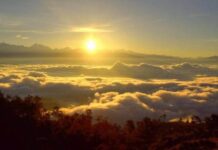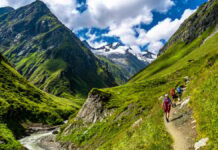Shivapuri Nagarjun National Park , located just north of Kathmandu Valley in Nepal, is a serene natural reserve known for its rich biodiversity and scenic landscapes. Established in 2002, the park covers 159 square kilometers and is home to various wildlife, including Himalayan black bears, leopards, and over 300 bird species. Its dense forests, primarily consisting of pine, oak, and rhododendron trees, provide an ideal habitat for these species. The park also features the Shivapuri Peak, a popular hiking destination that offers panoramic views of the surrounding hills and mountains.
In addition to its natural beauty, Shivapuri National Park holds religious and cultural importance. It is home to the source of the holy Bagmati River and several ancient monasteries and temples. Many visitors come for spiritual retreats, meditation, and trekking along the park’s peaceful trails. The Baghdwar area, a revered Hindu site, adds to the park’s cultural allure. Shivapuri National Park offers a perfect blend of nature, adventure, and spirituality, attracting both tourists and locals alike.
Table of Contents
Flora & Fauna
Shivapuri lies in a transition zone between subtropical and temperate climates. The vegetation consists of a variety of natural forest types including pine, oak, rhododendron etc., depending on altitude and aspect. Recorded wildlife in the park includes mammalian species such as Himalayan Black bear, leopard, jungle cat, and rhesus monkey. The park is also home to 177 species of birds, including at least 9 threatened species, 102 species of butterflies with a number of rare and endangered species, and 129 species of mushrooms.
 Salient Features of SNNP
Salient Features of SNNP
The notable features of Shivapuri Nagarjun National Park (SNNP) include:
- A major source of fresh water for Kathmandu valley
- A sink for air pollution
- An important watershed of Holy rivers Bagmati and Bishnumati
- A region of rich biodiversity of the mid-hill region
- An important biological corridor that links north-south
- An important bird area (IBA)
- One of the major tourist destinations nearby the capital city
- A potential area for research and exploration
- A site for conservation education for students and researchers
Types of Forests in SNNP
The different types of forests that can be found in Shivapuri Nagarjun National Park include the following varieties:
- Evergreen Forest
- Pine Forest
- Oak Forest
- Rhododendron Forest
- Mixed Forest
These forests harbor 1402 species of plants, of which 1114 species of flowering plants, 282 species of non-flowering plants gymnosperm, pteridophytes, and fungi. SNNP is home to one third species of orchids of Nepal (123 species). Similarly, 131 species of pteridophytes, 129 species of mushrooms, have been documented from SNNP. It comprises 124 species of butterflies, 122 species of insects, 348 species of birds, and 65 species of mammals.
Places of Interest
The park is easily accessible from Kathmandu. Visitors are attracted to the park for trekking. Trekking routes to Nagarkot, Gosaikunda, Helambu, and Langtang National Park also pass through the park. Several religious sites for the Hindus and the Buddhists lie inside the park. On Nepalese New Year’s Day, which falls in mid-April, pilgrims from Kathmandu valley and neighboring areas flock to Baghdwar and Bishnudwar of the park from where the sacred rivers Bagmati and Bishnumatii originate. Visitors can have breathtaking views of the high Himalayas from the northern aspects of the park. Likewise, the panoramic views of Kathmandu valley could be seen from the southern slopes of the park.
Climate
Shivapuri Nagarjun National Park experiences a diverse climate, influenced by its varying altitude, ranging from 110 to 850 meters above sea level. The park enjoys a subtropical climate, with hot summers, mild winters, and a monsoon season. Summer temperatures can rise up to 35°C, while winters see a drop to around 7°C. The monsoon season, from
June to September, brings heavy rainfall, contributing to the park’s lush greenery and water resources. Post-monsoon, the park experiences a cool and pleasant climate, making it an ideal time for visitors. The park’s microclimates, shaped by elevation changes, support a variety of ecosystems. Fog and humidity often linger in the lower altitudes, creating a vibrant environment for the diverse flora and fauna. These climatic conditions, along with the seasonal monsoons, are critical to sustaining the park’s dense forests and abundant wildlife.
Biodiversity
The park represents area of high biological diversity. There are 1273 different plant species in total found in the park. There are 65 mammalian species recorded in the park, six of them are assessed as nationally threatened. Chinese pangolin, Leopard cat, Clouded leopard, Assamese monkey found in the park are listed in protected animal list under the NPWC Act, 2029 (Paudyal et al,2023). Other common mammals found in the park are Common leopard, Himalayan black bear, Yellow throated marten, Barking deer and Sambar, etc. Similarly, the region is home to 320 species of birds (SNNP,2017). Likewise, 11 amphibian species and 20 reptile species (Shah,2016), 124 species of butterflies and 122 species of insects are found (Khanal, 2013) in SNNP.
Facilities
Shivapuri National Park offers a range of activities and attractions for visitors. The Visitor Information Center provides insights into the park’s biodiversity and conservation efforts. Nature walks and hiking trails allow guests to explore the rich flora and fauna, with opportunities to spot rare wildlife like the Himalayan black bear and barking deer. Birdwatchers will find the park a paradise with numerous species to observe. For a cultural experience, visitors can explore nearby monasteries and religious sites such as Nagi Gumba. Shivapuri also offers several picnic spots and serene viewpoints, perfect for relaxing and taking in the stunning natural beauty. Accommodation options include eco-friendly lodges and guesthouses outside the park, where guests can enjoy comfortable stays while planning further adventures. Guided tours and safaris are available to enhance the wildlife experience, ensuring a memorable visit for all nature enthusiasts.





